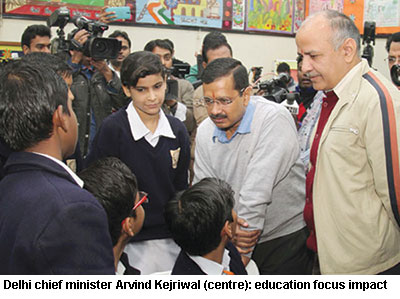 Ever since the aam aadmi (Common Man’s) Party (AAP) — a political formation born out of Gandhian social activist Anna Hazare’s abortive anti-corruption crusade of 2012 — swept the Delhi state legislative assembly election of 2015, unexpectedly trouncing the BJP fresh from its triumph in General Election 2014, it has always been in the thick of controversy.
Ever since the aam aadmi (Common Man’s) Party (AAP) — a political formation born out of Gandhian social activist Anna Hazare’s abortive anti-corruption crusade of 2012 — swept the Delhi state legislative assembly election of 2015, unexpectedly trouncing the BJP fresh from its triumph in General Election 2014, it has always been in the thick of controversy.
Winning the assembly election three years ago has proved to be a crown of thorns because Delhi falls under the administrative jurisdiction of the ruling party at the Centre as well. Therefore, the BJP which is the ruling party at the Centre and the AAP government of Delhi have been at loggerheads over almost every issue of governance, with the BJP, which is unreconciled to AAP’s sweeping victory — it won 67 of the 70 seats in the legislative assembly — losing no opportunity to dispute and/or veto the AAP government’s governance and social reform initiatives through the agency of the Lieut. Governor, the Centre’s chief executive of Delhi.
However, one area in which the AAP government has made a huge impact — and the Centre has not interfered for fear of a public backlash — is K-12 education, a major area of focus of the AAP government. In the current fiscal, the state government has allocated an impressive Rs.13,999 crore for education, equivalent to 26 percent of its total budget for education.
Relative to the population of Delhi state (18.4 million), AAP’s budgetary allocation for school education is a huge sum. It’s pertinent to note that the Central government’s 2018-19 budget for education — for the entire country — is Rs.85,010 crore and the education budget of the state government of Uttar Pradesh (pop.215 million) is Rs.64,213 crore.
Impressive budget allocations for education aside, the AAP government of Delhi state has taken several initiatives in public K-12 education which should serve as examples to other state governments. In 2016, it introduced its Chunauti and Pragati initiatives to provide remedial education to slow learners. Last year, teacher development coordinators programmes and principal cluster meets were started. On July 2, it rolled out a new pathbreaking initiative christened the Happiness Curriculum, designed to teach over 800,000 K-VIII children in Delhi’s 1,024 government schools universal human values and emotional well-being.
Designed by the State Council of Educational Research & Training (SCERT), in consultation with five NGOs with expertise and experience in life skills, child psychology and allied spheres, and inaugurated by the Dalai Lama with 18,000 government school teachers in attendance, the Happiness Curriculum has generated considerable excitement in the national capital. Happiness class handbooks have been designed for nursery to class VIII teachers, and government schools in Delhi will schedule a happiness class of 45 minutes every day.
“The objective of the Happiness Curriculum is to engage teachers and children in a process to make our next generation better human beings. We believe it will address several evils and shortcomings in their lives and society. That is how this new innovation is positioned,” says Shailendra Sharma, principal advisor in the Directorate of Education of the Delhi state government.
Monitors of the education sector in the national capital are somewhat skeptical about the impact of the Happiness Curriculum in government primaries/elementaries because the devil is in the implementation. Nevertheless, they concede that the AAP government’s budgetary provision, initiatives and innovations in public school education are unprecedented and worthy of support and emulation. Moreover, they discern an electoral design in AAP’s focus on public education. According to them, AAP strategists are planning to present the party’s acknowledged success in upgrading government schools in Delhi — AAP spokespersons cite data indicating that the average marks of government schools in the CBSE class X exams are higher than of private budget schools — as a winning strategy in General Election 2019 and/or the legislative assembly election of 2020.
Autar Nehru (Delhi)


























